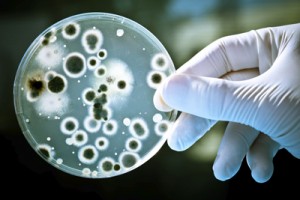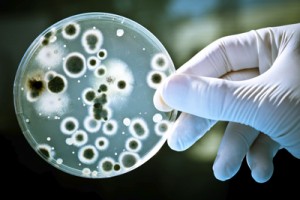 Some organisms, like bacteria, consist of only one cell. Other organisms, like humans, consist of trillions of specialized cells working together. Even if organisms look very different from each other, if you look close enough you’ll see that their cells have much in common.
Some organisms, like bacteria, consist of only one cell. Other organisms, like humans, consist of trillions of specialized cells working together. Even if organisms look very different from each other, if you look close enough you’ll see that their cells have much in common.
Most cells are so tiny that you can’t see them without the help of a microscope. The microscopes that students typically use at school are light microscopes.
Robert Hooke created a primitive light microscope in 1665 and observed cells for the very first time. Although the light microscope opened our eyes to the existence of cells, they are not useful for looking at the tiniest components of cells. Many structures in the cell are too small to see with a light microscope.
Please login or register to read the rest of this content.


You can try other places that have still water, like ponds, rain gutters, etc. 🙂 Look around and find a damp, wet place that’s a little swampy.
If I don’t have a dog, is there another animal that I could use instead?
Awww… thanks so much for letting me know about your situation! 🙂 I feel so honored that you’re trying us out, and we’re the first ones to make a great impression on you!
Okay, so there’s a couple of ways to use this program. Some folks get really excited and want to do ALL 1,000+ experiments on the site… and while you can certainly do that, it’s not really necessary do complete everything in order to get a great science education that more than covers what you need to know in science.
There are several different experiments and activities that cover the same science concepts, so if you’re on a budget or materials are just not available, feel free to either just watch the video and learn that way, or skip it entirely and move onto the ones you do have time and resources for.
The Life Science unit can be done without a microscope, however most colleges do expect kids to have some familiarity with how to use one, so it’s something that you’ll want to cover before sending them off, especially if they are interested in pursuing biology or life science. It’s a good gift idea for holidays or birthdays to ask for as well. (Note: I would NOT give kids a telescope but instead a nice pair of binoculars and access to Unit 7 in e-Science. You can read about why that is in my post here.)
Back to microscopes: you can do some of the lab using two magnifiers (read how to do this here), but you’re not going to get nearly the clarity or level of depth as you would using the real thing. But for younger kids, this is probably fine. You can also make a laser microscope from a laser pointer from the dollar store using the directions here.
Hope this helps! Keep in touch so I can help you along the way. 🙂
Hi Aurora! I just purchased the eScience program for my 2 daughters. I bought the membership for 2 reasons. One, my daughters love science and as a homeschool mom, and a former 2nd grade teacher, my resources are very limited as to what the girls’ charter school offers. That and I’m on a limited budget. In fact your program is the FIRST curriculum I’ve ever bought in the 5 1/2 years of homeschooling. I usually just use what the school gives me. So I want them to have a great science education. Second in your informational videos you mentions that most of your experiments use common household items to make it affordable.
So my question is, I noticed that when I have to teach units on cells I need a microscope. I don’t have one and unfortunately can’t afford one at the time. Do you have any other suggestions as how to complete some of these experiments? Or if I skip all of those experiments within the lesson and only do the experiments that I have the materials for, will that be enough hands on experience for them to learn and grasp the concepts taught.
Thank you in advance!
It depends on which type of bacteria you’re looking at. Some will move slowly, others not at all, and others wiggle all over the place. There’s a neat page about this here.
I can see the bacteria in my microscope,but i do not know if it’s supposed to move. Can it move in one days worth or will it take longer?
Sophie
I don’t have any dogs that actually LIKE me close by, so I just used two of my cats instead. Is that OK?
(Alexander Crawford, age 10)
Thanks Aurora, the gelatin is cooling in the dishes!
Agar is very similar to gelatin, and you can use regular unflavored gelatin from the grocery store as a replacement. You can also use beef broth with sugar added. As far as water in the petri dish, there’s no need to add water. If you’re going to use it as a medium on which to grow bacteria, just enough to cover the dish is fine.
If we don’t have any agar around, is there anything we can add to water to help the bacteria grow? (i.e. sugar, etc) Also, how much water do we put in the petri dish? Thanks.
Bacteria will always grow better in the presence of agar. So, if you have some around, it can’t hurt to add it to the Petri Dish. However, bacteria can grow without agar. Many liquids, (even water) can be used as a medium in which to grow bacteria, although agar has the nutrients that make it most effective.
So we don’t need to prep the Petri dishes with agar or anything?